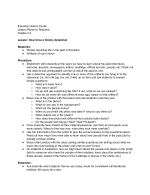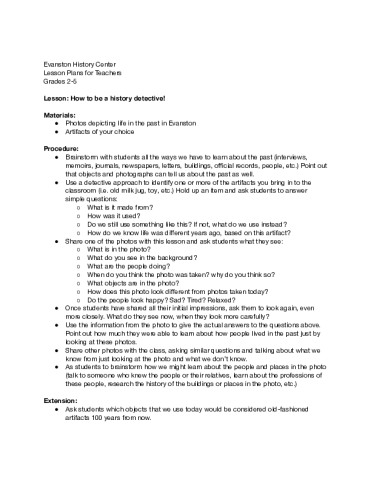Lesson Plan: How to be a History Detective!
Summary:
Lesson plans for teachers, grades 2-5, discussing with students what they know about Evanston history. Click to view the lesson plan and photographs. Downloadable PDF and images also available.Description:
This lesson plan focuses on the different ways you can learn about the past. Students will be detectives and work to identify historic artifacts and discuss old photographs.
LESSON PLAN:
Grades 2-5
Author: Dr. Jenny Thompson
Lesson: How to be a history detective!
Materials:
- Photos depicting life in the past in Evanston
- Artifacts of your choice
Procedure:
- Brainstorm with students all the ways we have to learn about the past (interviews, memoirs, journals, newspapers, letters, buildings, official records, people, etc.) Point out that objects and photographs can tell us about the past as well.
-
Use a detective approach to identify one or more of the artifacts you bring in to the classroom (i.e. old milk jug, toy, etc.) Hold up an item and ask students to answer simple questions:
- What is it made from?
- How was it used?
- Do we still use something like this? If not, what do we use instead?
- How do we know life was different years ago, based on this artifact?
-
Share one of the photos with this lesson and ask students what they see:
- What is in the photo?
- What do you see in the background?
- What are the people doing?
- When do you think the photo was taken? why do you think so?
- What objects are in the photo?
- How does this photo look different from photos taken today?
- Do the people look happy? Sad? Tired? Relaxed?
- Once students have shared all their initial impressions, ask them to look again, even more closely. What do they see now, when they look more carefully?
- Use the information from the photo to give the actual answers to the questions above. Point out how much they were able to learn about how people lived in the past just by looking at these photos.
- Share other photos with the class, asking similar questions and talking about what we know from just looking at the photo and what we don’t know.
- As students brainstorm how we might learn about the people and places in the photo (talk to someone who knew the people or their relatives, learn about the professions of these people, research the history of the buildings or places in the photo, etc.)
Extension:
- Ask students which objects that we use today would be considered old-fashioned artifacts 100 years from now.
- Break students into small groups. Give each group a photo and have them use their imagination to make up a story about the photo. Who are these people? What happened 5 minutes before the picture was taken and 5 minutes after it was taken? Have each group share their story with the class. Discuss the difference between the imagined information in the story and the facts we know from the photo.






